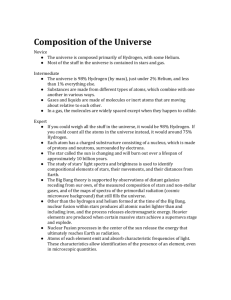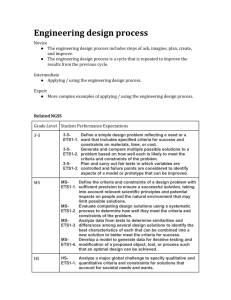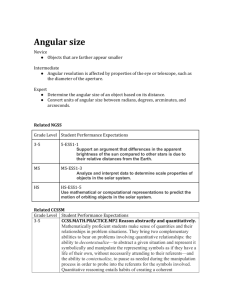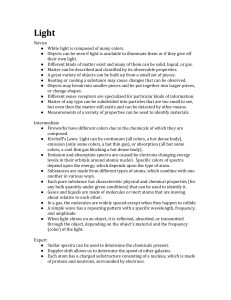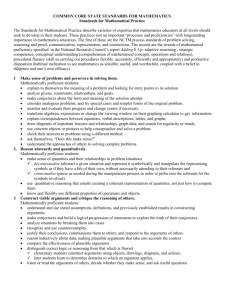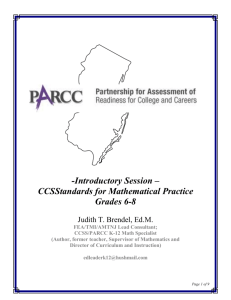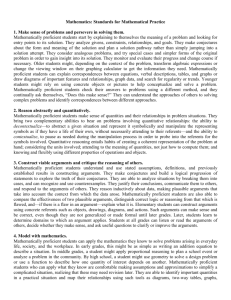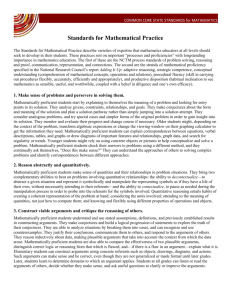docx
advertisement
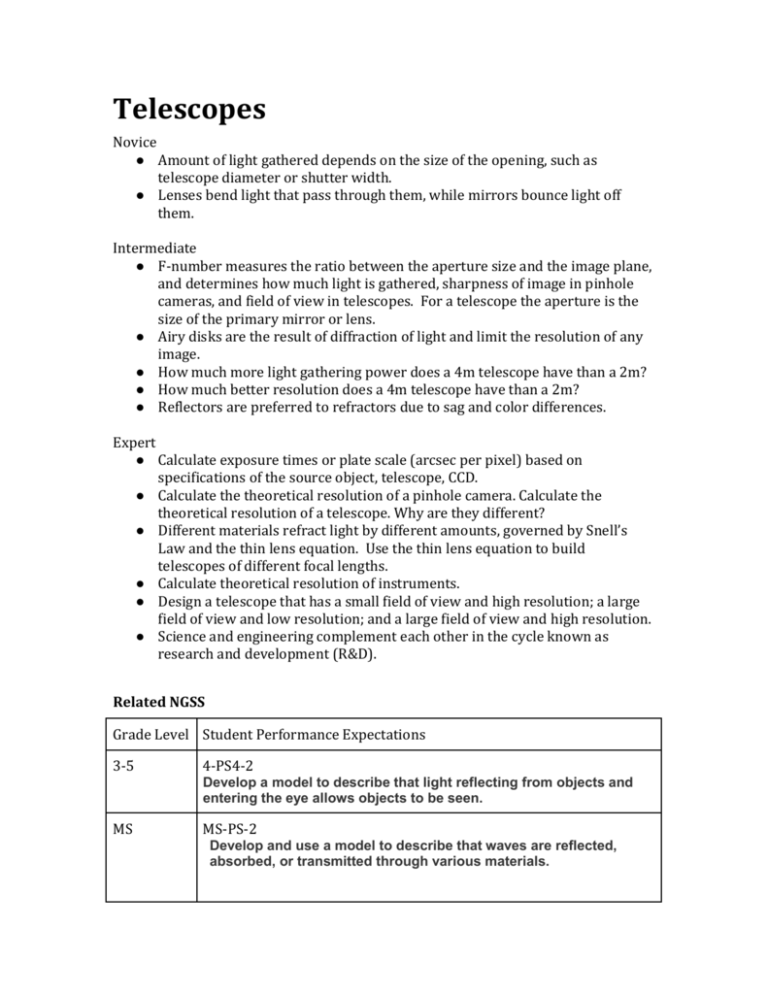
Telescopes Novice ● Amount of light gathered depends on the size of the opening, such as telescope diameter or shutter width. ● Lenses bend light that pass through them, while mirrors bounce light off them. Intermediate ● F-number measures the ratio between the aperture size and the image plane, and determines how much light is gathered, sharpness of image in pinhole cameras, and field of view in telescopes. For a telescope the aperture is the size of the primary mirror or lens. ● Airy disks are the result of diffraction of light and limit the resolution of any image. ● How much more light gathering power does a 4m telescope have than a 2m? ● How much better resolution does a 4m telescope have than a 2m? ● Reflectors are preferred to refractors due to sag and color differences. Expert ● Calculate exposure times or plate scale (arcsec per pixel) based on specifications of the source object, telescope, CCD. ● Calculate the theoretical resolution of a pinhole camera. Calculate the theoretical resolution of a telescope. Why are they different? ● Different materials refract light by different amounts, governed by Snell’s Law and the thin lens equation. Use the thin lens equation to build telescopes of different focal lengths. ● Calculate theoretical resolution of instruments. ● Design a telescope that has a small field of view and high resolution; a large field of view and low resolution; and a large field of view and high resolution. ● Science and engineering complement each other in the cycle known as research and development (R&D). Related NGSS Grade Level Student Performance Expectations 3-5 4-PS4-2 Develop a model to describe that light reflecting from objects and entering the eye allows objects to be seen. MS MS-PS-2 Develop and use a model to describe that waves are reflected, absorbed, or transmitted through various materials. HS HS-PS4-1 Use mathematical representations to support a claim regarding relationships among the frequency, wavelength, and speed of waves traveling in various media. Related CCSSM Grade Level 3-5 MS Student Performance Expectations CCSS.MATH.PRACTICE.MP4 Model with mathematics. Mathematically proficient students can apply the mathematics they know to solve problems arising in everyday life, society, and the workplace. In early grades, this might be as simple as writing an addition equation to describe a situation. In middle grades, a student might apply proportional reasoning to plan a school event or analyze a problem in the community. By high school, a student might use geometry to solve a design problem or use a function to describe how one quantity of interest depends on another. Mathematically proficient students who can apply what they know are comfortable making assumptions and approximations to simplify a complicated situation, realizing that these may need revision later. They are able to identify important quantities in a practical situation and map their relationships using such tools as diagrams, two-way tables, graphs, flowcharts and formulas. They can analyze those relationships mathematically to draw conclusions. They routinely interpret their mathematical results in the context of the situation and reflect on whether the results make sense, possibly improving the model if it has not served its purpose. CCSS.MATH.CONTENT.4.G.A.1 Draw points, lines, line segments, rays, angles (right, acute, obtuse), and perpendicular and parallel lines. Identify these in two-dimensional figures. CCSS.MATH.PRACTICE.MP2 Reason abstractly and quantitatively. Mathematically proficient students make sense of quantities and their relationships in problem situations. They bring two complementary abilities to bear on problems involving quantitative relationships: the ability to decontextualize—to abstract a given situation and represent it symbolically and manipulate the representing symbols as if they have a life of their own, without necessarily attending to their referents—and the ability to contextualize, to pause as needed during the manipulation process in order to probe into the referents for the symbols involved. Quantitative reasoning entails habits of creating a coherent representation of the problem at hand; considering the units involved; attending to the meaning of quantities, not just how to compute them; and knowing and flexibly using different properties of operations and HS objects. CCSS.MATH.CONTENT.6.EE.A.2 Write, read, and evaluate expressions in which letters stand for numbers. CCSS.MATH.CONTENT.7.EE.B.3 Solve multi-step real-life and mathematical problems posed with positive and negative rational numbers in any form (whole numbers, fractions, and decimals), using tools strategically. Apply properties of operations to calculate with numbers in any form; convert between forms as appropriate; and assess the reasonableness of answers using mental computation and estimation strategies. CCSS.MATH.CONTENT.7.EE.B.4 Use variables to represent quantities in a real-world or mathematical problem, and construct simple equations and inequalities to solve problems by reasoning about the quantities. CCSS.MATH.PRACTICE.MP2 Reason abstractly and quantitatively. Mathematically proficient students make sense of quantities and their relationships in problem situations. They bring two complementary abilities to bear on problems involving quantitative relationships: the ability to decontextualize—to abstract a given situation and represent it symbolically and manipulate the representing symbols as if they have a life of their own, without necessarily attending to their referents—and the ability to contextualize, to pause as needed during the manipulation process in order to probe into the referents for the symbols involved. Quantitative reasoning entails habits of creating a coherent representation of the problem at hand; considering the units involved; attending to the meaning of quantities, not just how to compute them; and knowing and flexibly using different properties of operations and objects. CCSS.MATH.PRACTICE.MP4 Model with mathematics. Mathematically proficient students can apply the mathematics they know to solve problems arising in everyday life, society, and the workplace. In early grades, this might be as simple as writing an addition equation to describe a situation. In middle grades, a student might apply proportional reasoning to plan a school event or analyze a problem in the community. By high school, a student might use geometry to solve a design problem or use a function to describe how one quantity of interest depends on another. Mathematically proficient students who can apply what they know are comfortable making assumptions and approximations to simplify a complicated situation, realizing that these may need revision later. They are able to identify important quantities in a practical situation and map their relationships using such tools as diagrams, two-way tables, graphs, flowcharts and formulas. They can analyze those relationships mathematically to draw conclusions. They routinely interpret their mathematical results in the context of the situation and reflect on whether the results make sense, possibly improving the model if it has not served its purpose. CCSS.MATH.CONTENT.HSA.SSE.A.1 Seeing structure in Expressions Interpret expressions that represent a quantity in terms of its context. CCSS.MATH.CONTENT.HSA.SSE.B.3 Seeing structure in Expressions Choose and produce an equivalent form of an expression to reveal and explain properties of the quantity represented by the expression. CCSS.MATH.CONTENT.HSA.CED.A.4 Creating Equations Rearrange formulas to highlight a quantity of interest, using the same reasoning as in solving equations.
